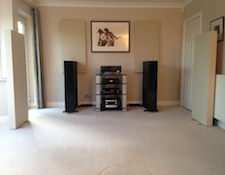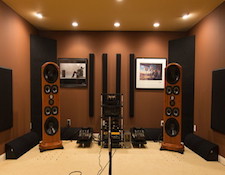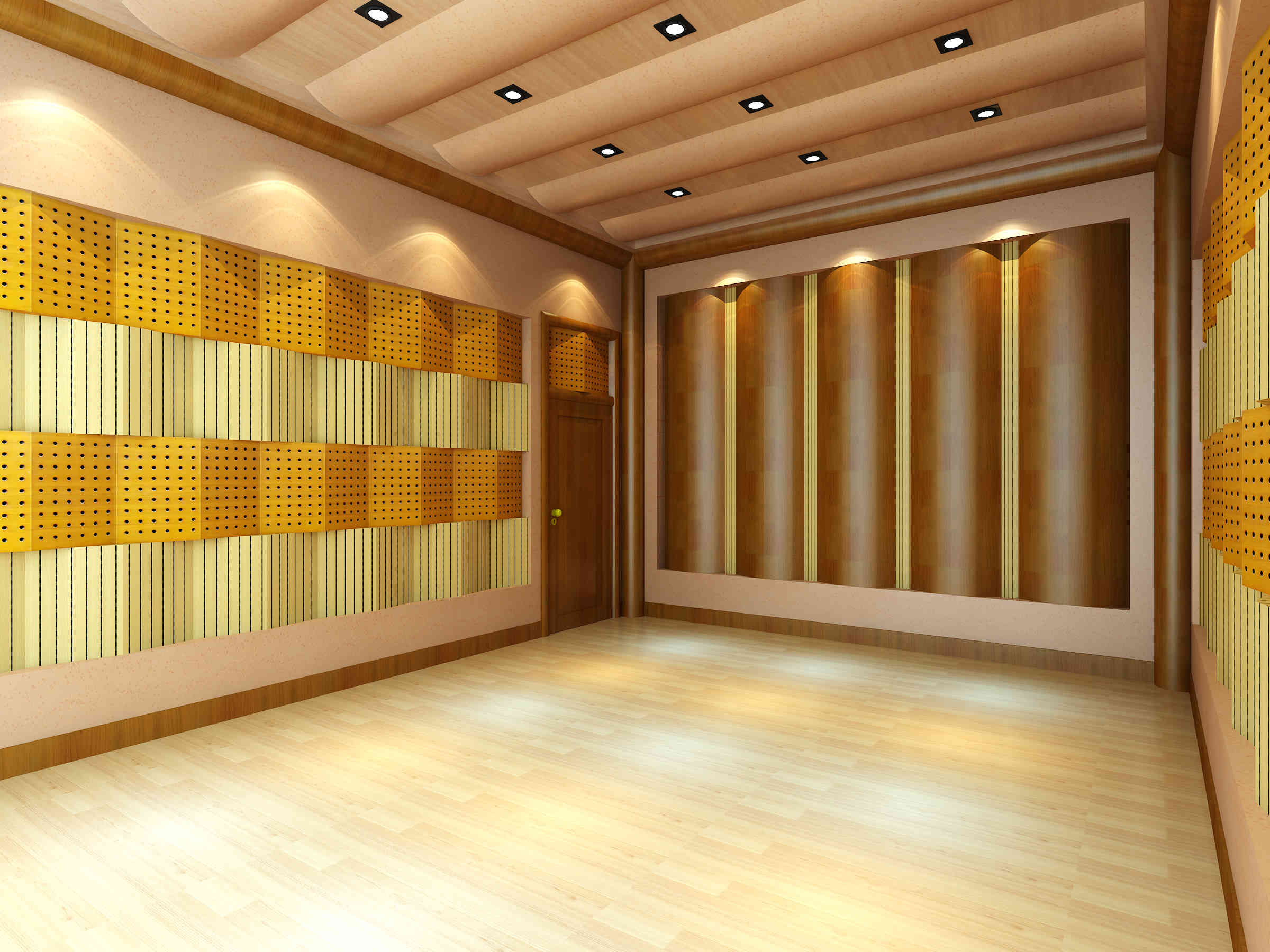It’s the time of year for saving money!
In Part 4 of this continuing series, I started to write about “High Intention” systems – the kinds of Hi-Fi system that, unlike a refrigerator or other home appliance, we DON’T intend to just keep for as long as it works and then repair or replace, but that will change from time to time as our interest, our budget, or our level of commitment to our audio hobby changes and as new toys and goodies become available to attract our buying attention.
 You may wonder at this point why I don’t use the more common term “High-End”, instead of “High Intention” for describing this kind of system. The reasons are simple: The first is that “High-End” is often taken to mean “Expensive” or even “Violently Expensive”, and a High Intention system – while it certainly does (as we are told the High-End systems do) seek to believably re-create a musical performance instead of just providing casual background sound (like the “keeper” systems described in earlier articles) – it doesn’t have to be exceptionally expensive; just noticeably “real”-sounding. The second is that, while High-End usually does mean expensive, expensive doesn’t necessarily mean “real”-sounding. I shudder to think of all of the truly expensive systems I’ve heard that fall far short of sounding anything like “real” or “live” music.
You may wonder at this point why I don’t use the more common term “High-End”, instead of “High Intention” for describing this kind of system. The reasons are simple: The first is that “High-End” is often taken to mean “Expensive” or even “Violently Expensive”, and a High Intention system – while it certainly does (as we are told the High-End systems do) seek to believably re-create a musical performance instead of just providing casual background sound (like the “keeper” systems described in earlier articles) – it doesn’t have to be exceptionally expensive; just noticeably “real”-sounding. The second is that, while High-End usually does mean expensive, expensive doesn’t necessarily mean “real”-sounding. I shudder to think of all of the truly expensive systems I’ve heard that fall far short of sounding anything like “real” or “live” music.
One High-End system that I’ve heard that was both inordinately expensive and exquisitely real-sounding was at the home in Brazil of what must certainly be one of the world’s greatest audiophiles. This gentleman (whose name I have not been given permission to use) has a separate “music room” built adjacent to his actual house in Brazil’s interior, hours away from Recife at the very eastern tip of South America. Architect- and acoustician-built, this room is proportioned for perfect acoustics and, in addition to carefully-chosen interior textures for its walls, floor, and ceiling, has something that is brilliant; works perfectly; and that I had never encountered before – “open” corners.
 It’s long been known that the corners of any room – the place where two walls and (either/and/or) the room’s floor or ceiling come together — are “high pressure” areas from an acoustic standpoint. In fact, people who, for whatever reason, have wanted to boost the bass output of their speakers have been taking advantage of that knowledge for a good long time — by placing their bass speakers (for reasons I’ll go into later, separate subwoofers work best for this) either up against the two-surface interface of one wall and the floor or ceiling for more bass, or against the three-surface interface of a corner and the floor or ceiling for even more bass than that. The Klipschorn and other “corner horn” designs also took advantage of corner speaker placement to effectively extend the length and “mouth”-size of their speakers’ bass horn, and thus extend their low-frequency cutoff point.
It’s long been known that the corners of any room – the place where two walls and (either/and/or) the room’s floor or ceiling come together — are “high pressure” areas from an acoustic standpoint. In fact, people who, for whatever reason, have wanted to boost the bass output of their speakers have been taking advantage of that knowledge for a good long time — by placing their bass speakers (for reasons I’ll go into later, separate subwoofers work best for this) either up against the two-surface interface of one wall and the floor or ceiling for more bass, or against the three-surface interface of a corner and the floor or ceiling for even more bass than that. The Klipschorn and other “corner horn” designs also took advantage of corner speaker placement to effectively extend the length and “mouth”-size of their speakers’ bass horn, and thus extend their low-frequency cutoff point.
What happens, though, when, like that Brazilian, truly committed Hi-Fi Crazy, you have more money than you can throw rocks at; you own, among other things, a set of Wilson WAMM speakers capable of making all the bass you could ever want; and you have no tolerance at all for the negative effects that corners can also present to the unwary? You could, of course, have your people build you a round room with no corners, but the effects of its acoustical reflections at higher frequencies could make for even worse problems.
OR
You could have your room made with brick corners laid so that each brick crosses the next at the corners in such a manner as to leave a half-brick-sized hole on one side of the corner for each succeeding course of bricks of which the corner wall is built up. (To see what I mean, hold your arms at right angles to each other and interlock just the tips of the fingers of both your hands to form a “corner”. See the holes between the fingers? That’s what I’m talking about.) In Brazil’s warm climate, having the corners of the room “wide-open” for the free passage of air or sound pressure doesn’t ever create a heating/cooling problem; the interlocking bricks keep out the bigger creatures of the Brazilian jungle; a simple wire screen keeps out the smaller ones; and, acoustically, the room has no troubling corners to deal with; can still be furnished conventionally; and has conventional walls that can be decorated as desired and given conventional acoustical treatments as necessary.
 It WORKED brilliantly, and was unquestionably the best sounding home listening room I’ve ever been in, but what if your listening room is in your basement? Or you live in an apartment? Either of those would make it pretty hard to have open corners. What, also, about climate concerns? If you DON’T live in a perpetually warm climate, having open corners – even if it’s otherwise possible — could make for real problems. Fortunately, there are still a great many things that you can do to make your own listening room sound better, and, unless you have both the means and the desire, they won’t call for either an architect or an acoustician.
It WORKED brilliantly, and was unquestionably the best sounding home listening room I’ve ever been in, but what if your listening room is in your basement? Or you live in an apartment? Either of those would make it pretty hard to have open corners. What, also, about climate concerns? If you DON’T live in a perpetually warm climate, having open corners – even if it’s otherwise possible — could make for real problems. Fortunately, there are still a great many things that you can do to make your own listening room sound better, and, unless you have both the means and the desire, they won’t call for either an architect or an acoustician.
The very first thing to do is to make the decision that your listening room really will be a Listening Room. If you can’t actually make critical (or at least serious) listening the primary purpose of your room; if, instead, it must also be usable for other things and those other things must come first, the high intentions of your High-Intention system may never be possible to realize, and it might be best for you to either pick a different room or re-examine the hierarchy of things that are important to you.
Once you’ve done that and finalized on which room you’re going to use, take a look at its overall shape: Is it square? Is it a rectangle with one pair of longer walls and one pair of shorter ones? Is it some other shape or a mix of shapes, like a rectangle with one rounded wall or a wall that’s all or partially set at something other than a 90°angle? Are all of its walls complete? Or is one or more walls interrupted by a door or a walk-through area, to merge with another room or acoustical space.
 Normally, when furnishing a room, we furnish it appropriately to its purpose or purposes (living room, den, bedroom, etc.) and arrange the furnishings and décor items so that they will look best. This time, though, forget, at least initially, how things look and concentrate just on how they’re likely to sound.
Normally, when furnishing a room, we furnish it appropriately to its purpose or purposes (living room, den, bedroom, etc.) and arrange the furnishings and décor items so that they will look best. This time, though, forget, at least initially, how things look and concentrate just on how they’re likely to sound.
I seem to recall being told that that free-standing, state-of-the-art listening room in Brazil had cost its owner more than US$1MM in building costs and fees to the various experts involved. In my next couple of articles, I’m going to show you how you can get noticeably better sound from your listening room for vastly less than that and, in some cases, possibly even no money at all. One of the first things covered will be “the corner problem”, and I’ll guarantee that – unless you really want to – you’re not going to have to call in a building contractor.
Interested? Good; see you next time.








